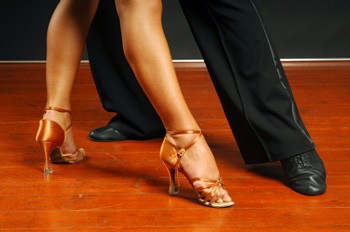WHY are Heel VS Ball Leads Used in Ballroom Dance Movements?

We’ve all heard it – take normal walking steps (i.e. walk normally) in smooth/standard dance movements, slide the ball or toe along the floor in rhythm/Latin dance movements. But the WHY behind this is often poorly explained, or even more poorly understood. Let’s do some digging, shall we?
First, a quick explanation for the beginners: “Heel leads” mean we step forward onto the heel of our foot and roll to the ball, or lift the toe and pull the heel back on a backward step, switching to a ball as it travels behind you. “Ball leads” simply mean sliding the balls of your feet along the floor. The heels can lift and lower, but the balls? Never.
Let’s start with the basic premise that we often hear regarding heel and ball leads. Heel leads help us take smooth, long steps that flow naturally from one into the next. Ball or toe leads improve our floor connection and keep us grounded, which helps with changing direction and adding Latin hip action.
So, why do you still feel like an awkward unbalanced mannequin when you do this? Probably because where the body is during your dance movements is just as important as where the feet are.
For example, in smooth/standard, the feet travel further ahead of the body than in rhythm/Latin. This allows the foot to swing like a pendulum under your body, creating a smooth weight transition or “body flight”, as we ballroom-types call it.
Assuming you aren’t arbitrarily pointing your toe, this will naturally cause the heel to be close to the floor on the forward half of the dance movement, and the toe to be close to the floor on the back half of the dance movement. Sliding the heel also reduces resistance on the floor, making for easier and lighter travel.
However, if you lean into the movement or don’t swing your foot enough, your foot can become “stuck” underneath you, leading to a jerky, stiff movement that doesn’t explore your full range of motion. In this case, the ball of your foot acts as an anchor on the ground, preventing you from traveling further without falling.
In a rhythm/Latin dance, we don’t need distance and momentum as much. What we do need, is balance and control; keeping our blocks of weight aligned above our traveling foot is VERY important. Try taking big swinging steps in a salsa or cha cha, and you’ll soon find your feet slipping out from under you.
Since we need to “stick” to the floor more, this is where the balls of our feet shine. Think of tennis players, and how quickly they change direction on the court. Could they still do that if they balanced on their heels? Pushing off the balls of your feet allows you to powerfully drive yourself through any rhythm/Latin dance movement.
So to rephrase the original premise for heel and ball leads: Heel leads help create a natural swinging action and reducing resistance, perfect for distance and momentum. Ball leads anchor your feet to the floor and allow you to change directions more quickly. And having correct body positioning is crucial for both of those dance movements.
About the Author
Ian Crewe has been dancing ballroom for over 18 years, and has a Licentiate in American smooth and rhythm. His passion for dance eventually led him to blogging and the World Wide Web. Ian currently teaches at the Joy of Dance Centre, Toronto, ON, Canada.

